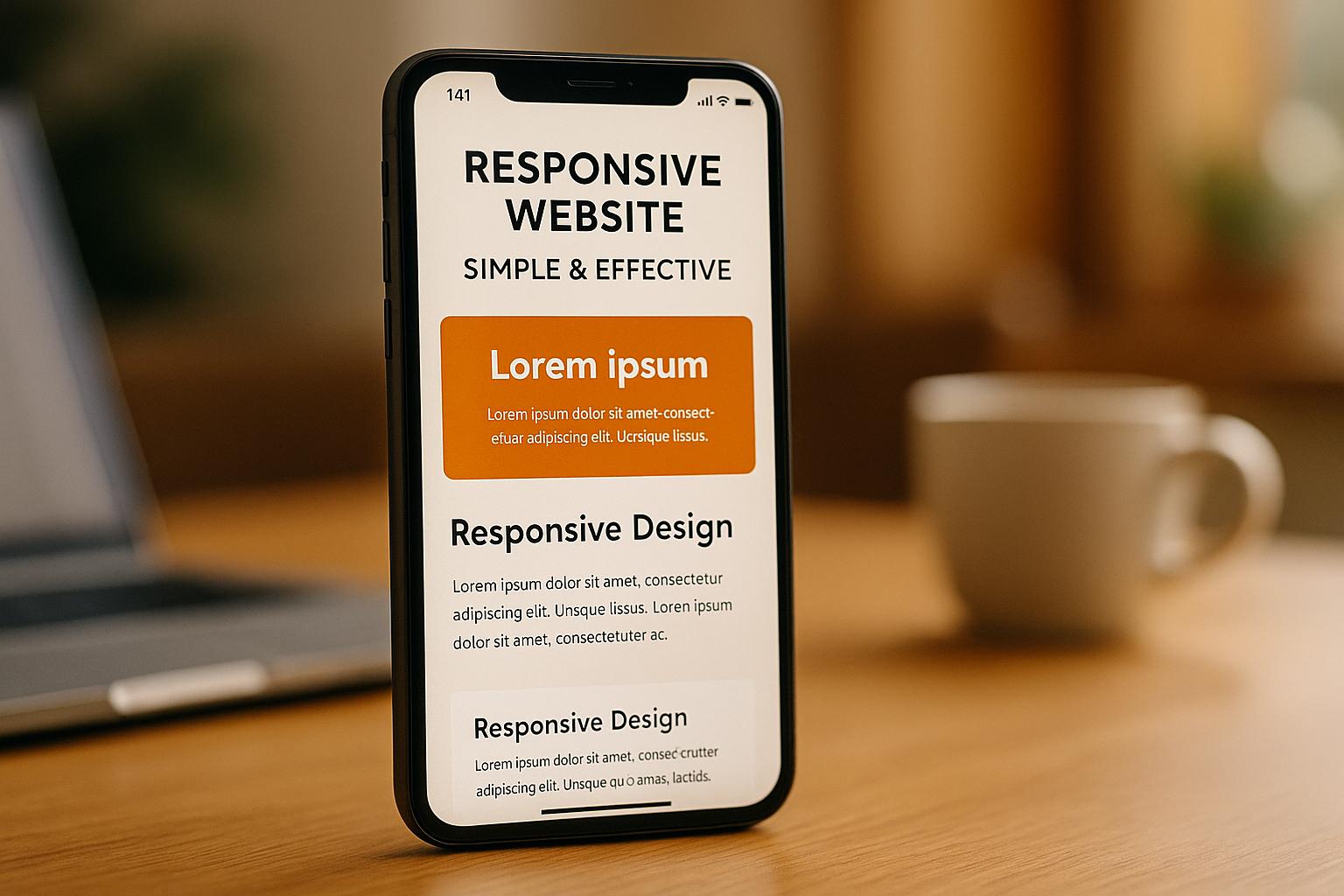<meta name="viewport" content="width=device-width, initial-scale=1.0"> is one of the most important lines of code for making your website mobile-friendly. Why? Because it tells browsers how to display your site on different devices, ensuring your content looks good and functions well on screens of all sizes.
With mobile-first indexing, Google prioritizes the mobile version of your site for rankings. If your website isn’t optimized for mobile devices, you risk losing traffic and visibility. Proper viewport settings improve user experience, reduce bounce rates, and meet Google’s mobile-friendly criteria.
Key Takeaways:
- What it does: Adjusts your site’s width and scale for different devices.
- Why it matters: Directly impacts mobile usability, SEO rankings, and user engagement.
- Best practice: Always include
<meta name="viewport" content="width=device-width, initial-scale=1.0">in your HTML. - Common mistakes: Omitting the tag, using fixed widths, or restricting zoom can hurt usability and rankings.
If your site isn’t mobile-friendly, now’s the time to fix it. A simple viewport tag can make all the difference.
How to Fix Mobile Usability Viewport Not Configured Issues
How Viewport Meta Tags Affect Mobile SEO Performance
Viewport meta tags play a crucial role in shaping user experience and influencing the performance metrics that search engines evaluate. When used correctly, they can significantly improve various aspects of a mobile SEO strategy.
Better User Experience
Viewport tags are essential for creating a smooth mobile browsing experience. Without them, mobile devices often display desktop layouts, forcing users to pinch, zoom, and scroll horizontally just to interact with content. This can quickly frustrate users and lead them to abandon the site altogether.
By using a tag like <meta name='viewport' content='width=device-width, initial-scale=1'>, you can ensure that text is easy to read, images adjust to screen size, and navigation works seamlessly. With mobile search queries now surpassing desktop searches, delivering a hassle-free mobile experience is non-negotiable. When users can easily read content, tap buttons, and navigate menus designed for touchscreens, they’re more likely to complete actions like making a purchase or filling out a form. These improvements often translate into better engagement metrics, which are critical for performance evaluation.
Effect on Search Engine Rankings
Improving the mobile user experience doesn’t just please visitors – it also catches the attention of search engines. Google’s algorithms prioritize mobile-friendly websites, making viewport meta tags a key component of any mobile optimization strategy. Mobile usability is a direct ranking factor, and sites that fail to provide a smooth experience risk penalties in mobile search results.
John Mueller from Google has emphasized the importance of viewport tags:
"Viewport meta tag is a good thing. Use it on all of your pages".
He further added:
"Viewport meta tag is a good way to make sure your website looks good on all devices. It’s also a signal to search engines that your website is mobile-friendly".
These insights highlight how proper viewport settings not only help avoid penalties but also offer competitive advantages. A better mobile experience leads to stronger engagement signals, such as reduced bounce rates and longer session durations, which in turn improve rankings over time.
Mobile Optimization Case Studies
Real-world examples demonstrate the tangible benefits of proper viewport configuration. For instance, Retailer A implemented responsive design and precise viewport tags, which led to an increase in mobile traffic and conversions. By improving user engagement, they achieved higher conversion rates, proving that technical mobile optimizations can directly impact business outcomes.
Similarly, Service Provider B focused on simplifying mobile navigation and resolving usability issues, including viewport settings. These changes resulted in improved user satisfaction and better engagement metrics. A more user-friendly mobile experience not only boosted their rankings but also strengthened customer loyalty.
These case studies illustrate that optimizing viewport settings is a fundamental step in any mobile strategy. Without proper configuration, even the most polished mobile designs can fall short, leaving users frustrated. Technical precision in viewport implementation lays the groundwork for better engagement and improved core web metrics, ensuring long-term success in mobile SEO.
Technical Best Practices for Viewport Meta Tags
Getting the viewport meta tag right is crucial – small mistakes can lead to a poor mobile experience and hurt your SEO.
Proper Tag Implementation
A correctly configured viewport meta tag is straightforward but critical. To make sure your site displays well on mobile devices, insert this tag in the <head> section of your HTML:
<meta name="viewport" content="width=device-width, initial-scale=1.0"> Here’s how it works:
width=device-width: This tells the browser to match the content width to the device’s screen width, ensuring your layout adjusts properly across different screen sizes.initial-scale=1.0: This sets a 1:1 ratio between CSS pixels and device pixels, avoiding unwanted zoom effects.
It’s essential to place this tag before any CSS or JavaScript files so that the correct scaling is applied right from the start.
Common Implementation Mistakes
Even with good intentions, it’s easy to make mistakes with viewport tags. Here are some common pitfalls:
- Omitting the tag altogether: Without a viewport tag, your site may appear zoomed out or poorly scaled on mobile screens.
- Using fixed-width viewports: Setting a specific width like
width=320orwidth=480can cause issues on devices with different screen sizes, leading to awkward layouts. - Including multiple viewport tags: This can confuse browsers, resulting in inconsistent behavior.
- Improper scaling settings: Missing or incorrect attributes can cause horizontal scrolling or content spilling off the screen.
User Zoom and Accessibility Settings
Allowing users to zoom is a critical part of making your site accessible. Settings like user-scalable=no or limiting maximum-scale can hinder accessibility, especially for users with visual impairments. Instead, aim to:
- Enable natural zooming while keeping the layout intact.
- Test how content reflows across various devices to ensure text remains readable, buttons are easy to tap, and navigation stays functional.
sbb-itb-880d5b6
Viewport Optimization and Core Web Vitals
Core Web Vitals have become a major factor in Google’s ranking algorithm, making viewport optimization more important than ever. When used effectively, viewport meta tags can play a critical role in improving these performance metrics.
Core Web Vitals and Mobile Performance
Core Web Vitals focus on three key metrics that reflect the quality of the user experience on your site:
- LCP (Largest Contentful Paint): This measures how quickly key content – like images, videos, or text – loads. Surprisingly, 40% of websites still don’t meet the recommended LCP threshold for a good user experience.
- FID (First Input Delay): This tracks how quickly a page becomes interactive after a user tries to engage with it, which is crucial for keeping mobile users satisfied.
- CLS (Cumulative Layout Shift): This measures visual stability by looking at unexpected layout shifts during loading, a common issue on mobile devices.
Google research shows that websites meeting the Core Web Vitals benchmark are 24% less likely to lose visitors. Yet, a recent Screaming Frog study revealed that only 12% of mobile and 13% of desktop results passed the Core Web Vitals test. These numbers highlight the importance of optimizing viewports to enhance mobile performance.
How Viewport Tags Support Core Web Vitals
Proper viewport configuration directly impacts Core Web Vitals by improving responsiveness and visual stability. The viewport meta tag ensures that browsers display content correctly across different screen sizes, avoiding unnecessary adjustments.
For example, using the configuration width=device-width, initial-scale=1 prevents mobile browsers from initially rendering pages at desktop widths and then scaling them down. This eliminates layout shifts, which improves CLS scores.
For LCP, a well-configured viewport ensures that content loads in the correct size and proportions from the start, reducing the need for browsers to recalculate layouts. This speeds up resource loading, which is essential given that mobile devices now account for over 60% of global website traffic.
When it comes to FID, correct viewport settings reduce the computational load during page rendering, allowing browsers to prioritize making the page interactive more quickly. These optimizations not only improve Core Web Vitals but also strengthen your overall mobile SEO efforts, delivering a faster and more seamless user experience.
Complete Mobile Optimization Strategies
While viewport optimization is essential, it’s just one part of a comprehensive mobile strategy aimed at improving Core Web Vitals. Many companies have seen measurable success by focusing on these metrics. For instance, Vodafone improved its LCP by 31%, leading to an 8% increase in sales through technical upgrades. Similarly, Yelp reduced its P75 FCP (First Contentful Paint) from 3.25 seconds to 1.80 seconds – a 45% improvement – resulting in up to a 15% boost in conversion rates.
Here are additional strategies to enhance mobile performance:
- Image Optimization: Resize and compress images, use the WebP format, and leverage a Content Delivery Network (CDN) for faster loading. Explicitly define image and video sizes to prevent layout shifts.
- Resource Management: Minimize CSS and JavaScript files, preload critical resources, and eliminate unnecessary third-party scripts. Enable browser caching and ensure your pages are eligible for the back/forward cache (bfcache) to improve load times.
- Layout Stability: Avoid animations or transitions that can cause layout shifts. Break down long-running tasks into smaller, asynchronous processes to prevent layout thrashing.
Combining proper viewport configuration with these strategies creates a mobile experience optimized for all Core Web Vitals metrics. With 48% of users stating that a website’s design is the top factor in assessing a business’s credibility, improving these metrics can significantly enhance SEO rankings and drive business growth.
It’s worth noting that 54.2% of websites with data in the Chrome User Experience Report fail to meet the recommended thresholds for all three Core Web Vitals metrics. This gap presents a major opportunity for businesses to stand out by integrating viewport optimization into their broader mobile SEO strategy.
Maximizing Mobile SEO with Viewport Meta Tags
Key Takeaways
Viewport meta tags play a crucial role in creating a mobile-friendly experience, directly influencing both user satisfaction and search engine rankings. A well-optimized viewport ensures your website looks and functions correctly on mobile devices, reducing bounce rates and encouraging user engagement – both essential for mobile SEO success.
When set up properly, viewport tags help prevent layout shifts and speed up page loading, which aligns with Google’s Core Web Vitals standards. Considering Google’s focus on mobile-first indexing, websites lacking appropriate viewport settings can appear poorly on mobile screens, potentially harming search rankings. Plus, nearly half of users – 48% – judge a business’s credibility based on its website design, making mobile optimization even more critical.
As mobile technology continues to evolve, viewport tags keep your website adaptable to new devices and screen sizes. This adaptability ensures your site stays competitive and ready to deliver a smooth experience, setting the stage for measurable SEO improvements.
Next Steps for Businesses
To capitalize on these insights, businesses need to take actionable steps to improve their mobile performance. Start by conducting a thorough audit of your mobile optimization strategy. Test how your website performs across different devices and browsers, paying close attention to any issues with layout, zooming, or horizontal scrolling that could disrupt the user experience.
Real-world examples highlight the benefits of this approach. Businesses that have fine-tuned their viewport settings often see significant boosts in organic traffic and keyword rankings.
For a consistent mobile experience, make sure every page of your site includes the recommended viewport meta tag. While this is a strong starting point, combining it with other tactics – like optimizing images, managing resources efficiently, and stabilizing layouts – can create a more robust mobile strategy.
If you’re looking to take your mobile SEO efforts to the next level, professional expertise can make a big difference. Companies like SearchX specialize in technical SEO and mobile optimization, offering services that address viewport issues, analyze Core Web Vitals, and provide tailored strategies designed to meet Google’s mobile-first indexing standards.
With mobile devices now driving over 60% of global website traffic, neglecting viewport optimization could mean losing visitors, conversions, and rankings. Don’t wait – prioritize your mobile strategy today to stay ahead in the mobile-first landscape.
FAQs
How does the viewport meta tag help improve a website’s performance on mobile devices?
The viewport meta tag is essential for ensuring websites display properly on mobile devices. It sets the visible area of a webpage, allowing content to scale appropriately for smaller screens, which significantly improves the user experience.
This adjustment also influences Core Web Vitals, like Largest Contentful Paint (LCP) and Cumulative Layout Shift (CLS). By enabling proper scaling, the tag minimizes layout shifts and speeds up load times – key factors for mobile SEO and overall site performance.
What are the common mistakes to avoid when using viewport meta tags for mobile SEO?
When it comes to setting up viewport meta tags, a few common missteps can seriously hurt your mobile SEO. For starters, leaving out the viewport meta tag altogether can wreak havoc on how your site looks and functions on mobile devices. Then there’s the issue of using fixed widths – this approach can leave your site looking clunky or even unusable on smaller screens. Another frequent error is setting an incorrect initial-scale value, which can mess up your layout and make your content difficult to read or navigate. Finally, failing to fine-tune your viewport settings for various devices can result in inconsistent performance across different mobile platforms.
To keep things running smoothly, make it a priority to test your viewport configurations thoroughly. Adjust as needed to ensure your site delivers a smooth and user-friendly experience on all mobile devices.
How do viewport meta tags improve mobile SEO rankings?
Optimizing viewport meta tags plays a key role in boosting mobile SEO rankings. Why? Because it ensures your website is both mobile-friendly and responsive. These tags define how your site adjusts and displays across various screen sizes, creating a smoother experience for visitors – a factor search engines pay close attention to.
When properly set up, viewport meta tags help tackle common mobile issues like hard-to-read text, annoying horizontal scrolling, and sluggish load times. Fixing these problems not only makes your site more enjoyable for users but also aligns with the criteria search engines use for mobile-first indexing. The result? Better performance in search rankings and greater visibility for mobile audiences.




